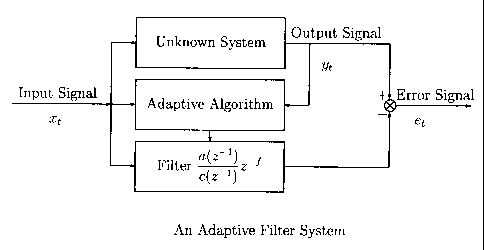Some of the information on this Web page has been provided by external sources. The Government of Canada is not responsible for the accuracy, reliability or currency of the information supplied by external sources. Users wishing to rely upon this information should consult directly with the source of the information. Content provided by external sources is not subject to official languages, privacy and accessibility requirements.
Any discrepancies in the text and image of the Claims and Abstract are due to differing posting times. Text of the Claims and Abstract are posted:
| (12) Patent Application: | (11) CA 2666292 |
|---|---|
| (54) English Title: | A NEW ALGORITHM FOR THE ADAPTIVEINFINITE IMPULSE RESPONSE FILTER |
| (54) French Title: | NOUVEL ALGORITHME POUR FILTRE ADAPTATIF A REPONSE IMPULSIONNELLE INFINIE |
| Status: | Deemed Abandoned and Beyond the Period of Reinstatement - Pending Response to Notice of Disregarded Communication |
| (51) International Patent Classification (IPC): |
|
|---|---|
| (72) Inventors : |
|
| (73) Owners : |
|
| (71) Applicants : |
|
| (74) Agent: | |
| (74) Associate agent: | |
| (45) Issued: | |
| (22) Filed Date: | 2009-05-25 |
| (41) Open to Public Inspection: | 2010-11-25 |
| Availability of licence: | N/A |
| Dedicated to the Public: | N/A |
| (25) Language of filing: | English |
| Patent Cooperation Treaty (PCT): | No |
|---|
| (30) Application Priority Data: | None |
|---|
A new method to adjust the parameters of an adaptive Infinite Impulse
Response (IIR) filter is suggested. The method adjusts the set of parameters
of the pole polynomial of the filter. The parameters of the zero polynomial
are calculated from the parameters of the pole polynomial. For efficiency,
the pole polynomial is factored into a product of polynomials with at most
quadratic order. To guarantee that the global minimum is achieved all the
time, the algorithm ascertains that the new set of pole parameters gives
smaller variance of the error than the set of pole parameters of the last
adaptation time and the algorithm starts with the set of parameters that
gives the global minimum.
Note: Claims are shown in the official language in which they were submitted.
Note: Descriptions are shown in the official language in which they were submitted.

2024-08-01:As part of the Next Generation Patents (NGP) transition, the Canadian Patents Database (CPD) now contains a more detailed Event History, which replicates the Event Log of our new back-office solution.
Please note that "Inactive:" events refers to events no longer in use in our new back-office solution.
For a clearer understanding of the status of the application/patent presented on this page, the site Disclaimer , as well as the definitions for Patent , Event History , Maintenance Fee and Payment History should be consulted.
| Description | Date |
|---|---|
| Time Limit for Reversal Expired | 2014-05-27 |
| Application Not Reinstated by Deadline | 2014-05-27 |
| Inactive: Abandon-RFE+Late fee unpaid-Correspondence sent | 2014-05-26 |
| Inactive: Adhoc Request Documented | 2014-02-27 |
| Deemed Abandoned - Failure to Respond to Maintenance Fee Notice | 2013-05-27 |
| Letter Sent | 2011-08-05 |
| Reinstatement Requirements Deemed Compliant for All Abandonment Reasons | 2011-07-26 |
| Deemed Abandoned - Failure to Respond to Maintenance Fee Notice | 2011-05-25 |
| Application Published (Open to Public Inspection) | 2010-11-25 |
| Inactive: Cover page published | 2010-11-24 |
| Inactive: IPC assigned | 2009-10-19 |
| Inactive: IPC assigned | 2009-10-15 |
| Inactive: IPC assigned | 2009-10-15 |
| Inactive: First IPC assigned | 2009-10-15 |
| Application Received - Regular National | 2009-06-11 |
| Filing Requirements Determined Compliant | 2009-06-11 |
| Inactive: Office letter | 2009-06-11 |
| Inactive: Filing certificate - No RFE (English) | 2009-06-11 |
| Small Entity Declaration Determined Compliant | 2009-05-25 |
| Abandonment Date | Reason | Reinstatement Date |
|---|---|---|
| 2013-05-27 | ||
| 2011-05-25 |
The last payment was received on 2012-04-16
Note : If the full payment has not been received on or before the date indicated, a further fee may be required which may be one of the following
Please refer to the CIPO Patent Fees web page to see all current fee amounts.
| Fee Type | Anniversary Year | Due Date | Paid Date |
|---|---|---|---|
| Application fee - small | 2009-05-25 | ||
| Reinstatement | 2011-07-26 | ||
| MF (application, 2nd anniv.) - small | 02 | 2011-05-25 | 2011-07-26 |
| MF (application, 3rd anniv.) - small | 03 | 2012-05-25 | 2012-04-16 |
Note: Records showing the ownership history in alphabetical order.
| Current Owners on Record |
|---|
| KY M. VU |
| Past Owners on Record |
|---|
| None |